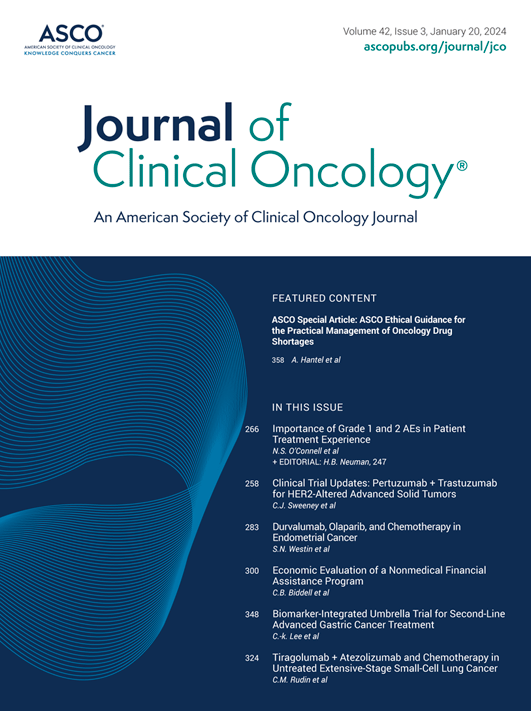Phase I Dose-Escalation Results for the Delta-Like Ligand 3/CD3 IgG-Like T-Cell Engager Obrixtamig (BI 764532) in Patients With Delta-Like Ligand 3+ Small Cell Lung Cancer or Neuroendocrine Carcinomas.
IF 42.1
1区 医学
Q1 ONCOLOGY
引用次数: 0
Abstract
PURPOSE We report phase I results for obrixtamig (BI 764532), a delta-like ligand 3 (DLL3)/CD3 IgG-like T-cell engager, in patients with previously treated DLL3-positive small cell lung cancer (SCLC), extrapulmonary neuroendocrine carcinomas (epNECs), or large cell neuroendocrine carcinoma of the lung (LCNEC-L). METHODS Patients received escalating intravenous obrixtamig doses using four regimens: a fixed dose once every 3 weeks (A); a fixed dose once weekly (B1); a step-up dose once weekly for two weeks and target dose once weekly (B2); and a step-up dose once weekly for 3 weeks, target dose once weekly for 3 weeks, and once every 3 weeks thereafter (B3). The primary objective was maximum tolerated dose (MTD). Secondary objectives included safety, pharmacokinetics, and tumor response (RECIST v1.1). RESULTS As of February 21, 2024, 168 patients received obrixtamig, 72% received ≥2 lines of previous anticancer therapy, and 51% received previous anti-PD-1/PD-L1 therapy. Seven dose-limiting toxicities occurred during MTD evaluation (Regimen A, n = 1; Regimen B2, n = 6). MTD was not reached. The most common treatment-related adverse event was cytokine release syndrome (any grade: 57%; grade ≥3: 3%); most cases occurred early and were reversible. Across all doses, regimens, and tumor types, the overall response rate (ORR) was 23% (95% CI, 17.4% to 30.2%), the median duration of response (DoR) was 8.5 months (95% CI, 6.2 to not reached), and the 6-month DoR rate was 70% (95% CI, 53% to 88%). All patients in Regimens B2/B3 received the minimum effective dose (≥90 μg/kg once weekly or once every 3 weeks), achieving an ORR of 28% (95% CI, 20.7% to 35.9%). With Regimens B2/B3, ORRs were 21% (95% CI, 12.9% to 33.1%), 27% (95% CI, 17.4% to 39.6%), and 70% (95% CI, 39.7% to 89.2%) for SCLC, epNECs, and LCNEC-L, respectively. CONCLUSION The demonstrated tolerability and efficacy of obrixtamig regimens, administered as step-up followed by target doses of 90-1,080 μg/kg (once weekly or once every 3 weeks), in patients with heavily pretreated DLL3-positive tumors support further exploration in SCLC, epNEC, and LCNEC-L.Delta-Like Ligand 3/CD3 igg样t细胞介入剂Obrixtamig (BI 764532)治疗Delta-Like Ligand 3+小细胞肺癌或神经内分泌癌的I期剂量递增结果
目的:我们报告obrixtamig (BI 764532),一种δ样配体3 (DLL3)/CD3 igg样t细胞结合剂,用于治疗DLL3阳性小细胞肺癌(SCLC)、肺外神经内分泌癌(epNECs)或肺大细胞神经内分泌癌(LCNEC-L)患者的I期研究结果。方法患者采用四种方案逐步递增静脉注射奥伐他明剂量:固定剂量每3周1次(a);每周一次固定剂量(B1);加强剂量每周一次,持续两周,目标剂量每周一次(B2);加强剂量每周1次,连续3周,目标剂量每周1次,连续3周,此后每3周1次(B3)。主要目标是最大耐受剂量(MTD)。次要目标包括安全性、药代动力学和肿瘤反应(RECIST v1.1)。结果截至2024年2月21日,168例患者接受了欧伐他明治疗,72%的患者既往接受过≥2种抗肿瘤治疗,51%的患者既往接受过抗pd -1/PD-L1治疗。MTD评估期间发生了7例剂量限制性毒性(方案A, n = 1;方案B2, n = 6)。没有达到预定时间。最常见的治疗相关不良事件是细胞因子释放综合征(任何级别:57%;等级≥3:3%);大多数病例发生早期且可逆转。在所有剂量、方案和肿瘤类型中,总缓解率(ORR)为23% (95% CI, 17.4%至30.2%),中位缓解持续时间(DoR)为8.5个月(95% CI, 6.2至未达到),6个月DoR率为70% (95% CI, 53%至88%)。B2/B3方案的所有患者均接受最低有效剂量(≥90 μg/kg,每周1次或每3周1次),ORR为28% (95% CI, 20.7% ~ 35.9%)。对于方案B2/B3, SCLC、epnec和LCNEC-L的orr分别为21% (95% CI, 12.9%至33.1%)、27% (95% CI, 17.4%至39.6%)和70% (95% CI, 39.7%至89.2%)。结论在重度预处理dll3阳性肿瘤患者中,以90- 1080 μg/kg为目标剂量(每周1次或每3周1次)给药的欧伐他明方案的耐受性和有效性支持了对SCLC、epNEC和LCNEC-L的进一步探索。
本文章由计算机程序翻译,如有差异,请以英文原文为准。
求助全文
约1分钟内获得全文
求助全文
来源期刊

Journal of Clinical Oncology
医学-肿瘤学
CiteScore
41.20
自引率
2.20%
发文量
8215
审稿时长
2 months
期刊介绍:
The Journal of Clinical Oncology serves its readers as the single most credible, authoritative resource for disseminating significant clinical oncology research. In print and in electronic format, JCO strives to publish the highest quality articles dedicated to clinical research. Original Reports remain the focus of JCO, but this scientific communication is enhanced by appropriately selected Editorials, Commentaries, Reviews, and other work that relate to the care of patients with cancer.
 求助内容:
求助内容: 应助结果提醒方式:
应助结果提醒方式:


